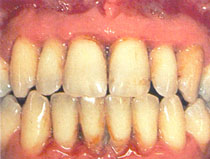Periodontal Disease
Up to 80 percent of the population unknowingly has some form of gum disease. Characterized by a persistent bacterial infection surrounding one tooth or several teeth, gum disease causes little or no discomfort and produces few obvious symptoms in the early stages. When periodontal disease is not treated, it will spread and compromise gums, teeth, bone and it can lead to heart disease and strokes, as well as diabetes and pregnancy complications. It is the leading cause for tooth loss in American adults.
Any of the following conditions greatly increases the risk of gum disease: smoking, tobacco use, certain medications, grinding your teeth, diabetes, poor nutrition, autoimmune diseases, and poor oral hygiene. Even patients who practice good home care routines can get gum disease. Gums irritated by bacteria can recede from the teeth, creating deep pockets where more bacteria can hide and grow.
The main symptoms you will notice early on are redness, swelling, and bleeding. At this stage, we can treat and reverse the gum disease. Regular check-ups greatly increase your potential for early detection and conservative treatment. Generally, treatment will include careful individualized instruction regarding the most effective means of brushing and flossing at home for you. The next step would be a professional scaling and smoothing of affected teeth with anesthetic if needed. We may even recommend placing an antibiotic, called Arestin, in the area to stop infection.
Arestin is a small amount of antibiotic powder that is easily pressed into the infected area by the dentist or hygienist. It releases for 14 days and kills the bacteria. Arestin, in combination with scaling and polishing of the teeth is one of the most effective ways to treat periodontal disease. Often, patients experience immediate improvement and continue to maintain through regular cleanings.

